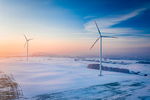News Release from International Renewable Energy Agency IRENA
Wind Industry Profile of
IRENA’s World Energy Transitions Outlook Re-Writes Energy Narrative for a Net Zero World Tweet
Accelerating energy transitions on a path to climate safety can grow the world’s economy by 2.4 per cent over the expected growth of current plans within the next decade, a new analysis from the International Renewable Energy Agency (IRENA) shows. The Agency’s 1.5°C pathway foresees the creation of up to 122 million energy-related jobs in 2050, more than double today’s 58 million. Renewable energy alone will account for more than a third of all energy jobs employing 43 million people globally, supporting the post-COVID recovery and long-term economic growth.
IRENA’s World Energy Transitions Outlook sees renewables-based energy systems instigating profound changes that will reverberate across economies and societies. Sharp adjustments in capital flows and a reorientation of investments are necessary to align energy with a positive economic and environmental trajectory. Forward-looking policies can accelerate transition, mitigate uncertainties, and ensure maximum benefits of energy transition. The annual investment of USD 4.4 trillion needed on average is high. But it is feasible and equals to around 5 per cent of global GDP in 2019.
“This Outlook represents a concrete, practical toolbox to total reorientation of the global energy system and writes a new and positive energy narrative as the sector undergoes a dynamic transition,” said Francesco La Camera, IRENA’s Director-General. “There is consensus that an energy transition grounded in renewables and efficient technologies is the only way to give us a fighting chance of limiting global warming by 2050 to 1.5°C. As the only realistic option for a climate-safe world, IRENA’s vision has become mainstream.”
“Energy transformation will drive economic transformation,” continued La Camera. “Energy transition is a daunting task but can bring unprecedented new possibilities to revitalise economies and lift people out of poverty. IRENA’s Outlook brings unique value as it also outlines the policy frameworks and financing structures necessary to advance a transition that is just and inclusive. Each country will define what is the best for them, but collectively, we must ensure that all countries and regions can realise the benefits of the global energy transition for a resilient and more equitable world. We have the know-how, we have the tools, we need to act, and do so now.”
The next decade will be decisive to achieve the Paris and Sustainable Developments goals. Any delay will drive us to the direction of further warming, with profound and irreversible economic and humanitarian consequences.
Phasing out coal, limiting investments in oil and gas to facilitate a swift decline and a managed transition as well as embracing technology, policy and market solutions will put the global energy system on track for a 1.5°C pathway. By 2050, a total USD 33 trillion of additional investment are required into efficiency, renewables, end-use electrification, power grids, flexibility, hydrogen and innovations. The benefits, however, greatly exceed the costs of investments.
When air pollution, human health and climate change externalities are factored in, the payback is even higher with every dollar spent on the energy transition adding benefits valued at between USD 2 and USD 5.5, in cumulative terms between USD 61 trillion and USD 164 trillion by the mid-century.
IRENA’s Outlook sees energy transition as a big business opportunity for multiple stakeholders including the private sector, shifting funding from equity to private debt capital. The latter will grow from 44 per cent in 2019 to 57 per cent in 2050, an increase of almost 20 per cent over planned policies. Energy transition technologies will find it easier to obtain affordable long-term debt financing in the coming years, while fossil fuel assets will increasingly be avoided by private financiers and therefore forced to rely on equity financing from retained earnings and new equity issues.
But public financing will remain crucial for a swift, just and inclusive energy transition and to catalyse private finance. In 2019, the public sector provided some USD 450 billion through public equity and lending by development finance institutions. In IRENA’s 1.5°C Scenario, these investments will almost double to some USD 780 billion. Public debt financing will be an important facilitator for other lenders, especially in developing markets.
As markets alone are not likely to move rapidly enough, policy makers must incentivise but also take action to eliminate market distortions that favour fossil fuels and facilitate the necessary changes in funding structures. This will involve phasing out fossil fuel subsidies and changing fiscal systems to reflect the negative environmental, health and social costs of fossil fuels. Monetary and fiscal policies, including carbon pricing policies, will enhance competitiveness and level the playing field.
Enhanced international cooperation and comprehensive set of policies will be critical to drive the wider structural shift towards resilient economies and societies. If not well managed, the energy transition risks inequitable outcomes, dual-track development and an overall slowdown in the progress. Just and integrated policies will remain imperative to realise the full potential of the energy transition.
Today’s policies, finance and socio-economic analysis completes the outlined technological avenues for a 1.5°C-comptabile energy pathway, providing policymakers with a playbook to achieve optimal results from the transition. Launched by energy leaders at the Agency’s Global High-Level Forum on Energy Transition, this Outlooks aims to raise ambition towards UN High-Level Dialogue on Energy and Climate Conference COP26 later this year.
Read the full World Energy Transitions Outlook.
- Source:
- IRENA
- Author:
- Press Office
- Link:
- irena.org/...
- Keywords:
- IRENA, World Energy Transition, outlook, renewables, policy, capital market, energy trransition, investment, grid, COVID, recovery
























